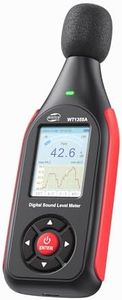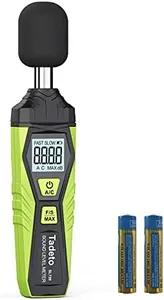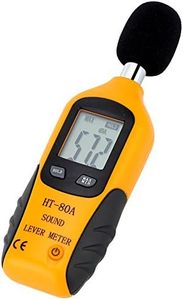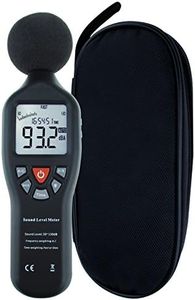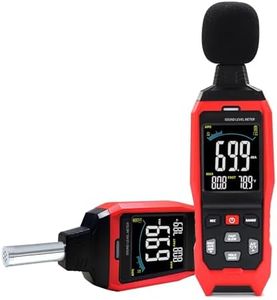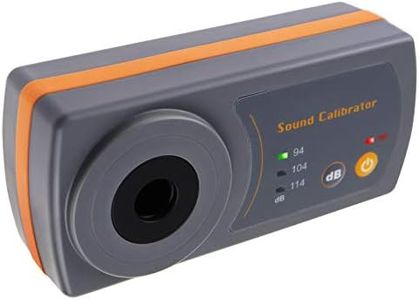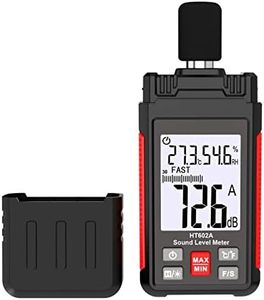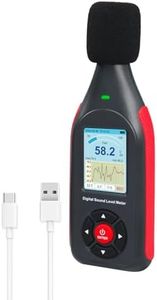We Use CookiesWe use cookies to enhance the security, performance,
functionality and for analytical and promotional activities. By continuing to browse this site you
are agreeing to our privacy policy
10 Best Sound Decibel Meters
From leading brands and best sellers available on the web.Buying Guide for the Best Sound Decibel Meters
Choosing a sound decibel meter can seem tricky, but understanding your needs and which features matter most will help you pick the best one. Sound decibel meters measure the level of noise in an environment, and are often used for everything from checking workplace safety to testing home audio setups. To find the right device for you, think about how often you'll use it, whether you need detailed or very basic readings, and in what types of environments you'll be measuring sound. Knowing these things will make it easier to match the features of different meters to your needs.Measurement RangeThe measurement range is how quiet or loud a meter can accurately detect and display sound levels, usually shown in decibels (dB). This matters because you need your meter to match the environment: if you’re measuring quiet rooms, look for a low starting range, but if you're checking loud environments, like construction sites or concerts, make sure the upper range covers louder sounds. Generally, a typical sound meter may measure from about 30 dB (whisper-soft) to 130 dB (very loud machinery). Select a meter where the conditions you want to measure fall comfortably within its range for the best accuracy.
AccuracyAccuracy tells you how close the meter's reading is to the real sound level. High accuracy is important if you need to comply with regulations, do professional assessments, or compare measurements over time. Entry-level meters might be accurate within ±2 dB, suitable for casual checks, while professional models may promise ±1 dB or better. Consider how critical this precision is for your use; for serious work, prioritize high accuracy, but for general monitoring or personal curiosity, slightly less accurate meters will often suffice.
Weighting Settings (A/C/Z Weighting)Weighting settings adjust the meter’s response to better match how humans perceive sound (A-weighting), represent near-flat responses for machinery or technical measurement (C-weighting), or produce an unfiltered result (Z-weighting). A-weighting is used for most human hearing and noise checks; C-weighting is helpful if you care about all frequencies including bass, often used with music or machines. If you’re measuring sound that affects people, A-weighting is usually the standard choice; for technical audio work, look for the additional options.
Response Time (Fast/Slow)Response time determines how quickly the meter reacts to changes in sound, typically with 'fast' (about 0.125 seconds) and 'slow' (about 1 second) modes. Fast response is good for measuring rapid changes in noise, such as in music or unpredictable environments, while slow response smooths out quick fluctuations for a steadier reading, which is helpful in steadier or averaged noise environments. Pick fast if you expect changing noise and need to see quick peaks; slow is easier for stable, consistent sounds.
Display FeaturesDisplay features refer to how the meter shows the data—digital screens are easiest to read, while analog meters might show trends over time. Some meters offer backlighting, which is handy in dim places, or can show minimum, maximum, and average readings. If you’ll be working in dark areas or need to record the highs and lows over time, pay attention to these features. For simple needs, a basic and clear display is enough, but if you want to analyze or document data, extra display functions can be useful.
Data Logging and ConnectivityData logging lets you save readings for future review, and connectivity options like USB or Bluetooth allow you to transfer this data to a computer or phone for analysis. This is important if you want to track changes over time or need official reports, such as for workplace monitoring. If you just want to check quick readings, you may not need this feature, but frequent users tracking trends will benefit from models with these abilities.
CalibrationCalibration ensures your meter’s readings stay accurate over time. Some meters offer built-in or automatic calibration, while others require an external calibrator. This is especially important if you need reliable, legal, or professional results. For casual users, pre-calibrated meters may suffice, but regular calibration is crucial for professional or legal applications to ensure ongoing accuracy.
